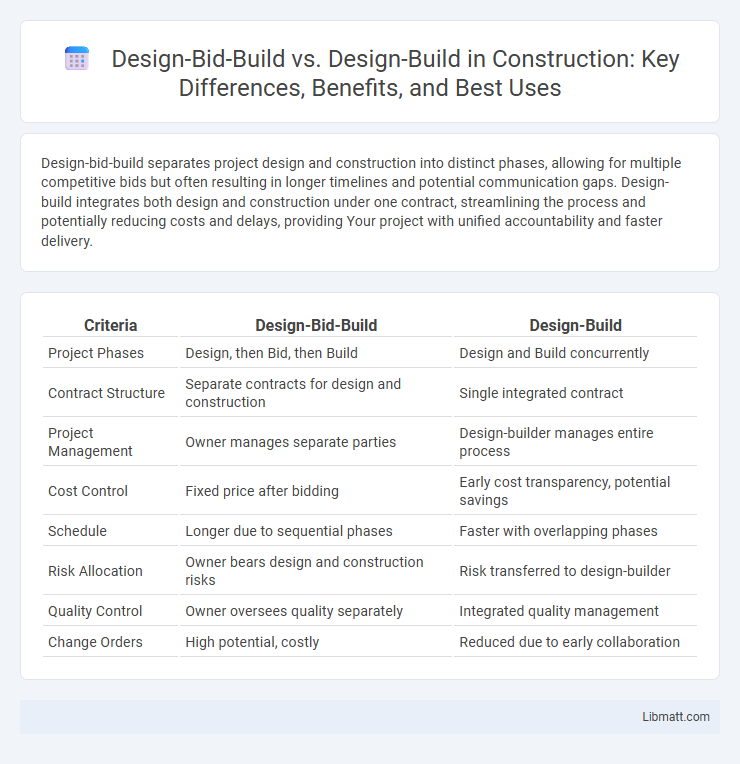Design-bid-build separates project design and construction into distinct phases, allowing for multiple competitive bids but often resulting in longer timelines and potential communication gaps. Design-build integrates both design and construction under one contract, streamlining the process and potentially reducing costs and delays, providing Your project with unified accountability and faster delivery.
Table of Comparison
| Criteria | Design-Bid-Build | Design-Build |
|---|---|---|
| Project Phases | Design, then Bid, then Build | Design and Build concurrently |
| Contract Structure | Separate contracts for design and construction | Single integrated contract |
| Project Management | Owner manages separate parties | Design-builder manages entire process |
| Cost Control | Fixed price after bidding | Early cost transparency, potential savings |
| Schedule | Longer due to sequential phases | Faster with overlapping phases |
| Risk Allocation | Owner bears design and construction risks | Risk transferred to design-builder |
| Quality Control | Owner oversees quality separately | Integrated quality management |
| Change Orders | High potential, costly | Reduced due to early collaboration |
Introduction to Project Delivery Methods
Design-bid-build is a traditional project delivery method where the design and construction phases are separate, requiring competitive bidding after the design is complete. Design-build integrates both design and construction under a single contract, promoting collaboration and reducing project timelines. Choosing the right method impacts cost control, risk management, and overall project efficiency in construction management.
Understanding Design-Bid-Build
Design-Bid-Build is a traditional project delivery method where the project owner first completes the design phase before soliciting bids from contractors, ensuring clear contractual separations. This method offers a transparent process with competitive bidding, which can lead to cost certainty but may lengthen the overall timeline due to sequential phases. Understanding Design-Bid-Build helps You evaluate its suitability for projects prioritizing detailed design control and a clear distinction between design and construction responsibilities.
Overview of Design-Build
Design-Build is a project delivery method where a single entity handles both design and construction, streamlining communication and responsibility. This approach contrasts with Design-Bid-Build, which separates design and construction phases, often leading to longer timelines and potential conflicts. Design-Build fosters collaboration, reduces risks, and can accelerate project completion by integrating design and construction processes under one contract.
Key Differences Between Design-Bid-Build and Design-Build
Design-bid-build separates project phases, with the owner contracting separately with designers and builders, resulting in clearer roles but longer timelines and potential for disputes. Design-build integrates design and construction under one contract, enhancing collaboration and accelerating project delivery while streamlining communication and accountability. Cost predictability typically favors design-build due to early contractor involvement, whereas design-bid-build may encounter change orders and budget overruns from design changes during construction.
Advantages of Design-Bid-Build
Design-bid-build offers clear separation of responsibilities by having distinct phases for design and construction, which allows for thorough project evaluation and competitive bidding that can lead to cost savings. This method provides owners with greater control over the design process and contract terms, ensuring adherence to project specifications. It also facilitates accountability by clearly delineating the roles of architects and contractors, reducing the potential for conflicts during construction.
Advantages of Design-Build
Design-Bid-Build offers clear advantages, such as well-defined project phases that separate design and construction, enabling detailed cost estimates and competitive bidding. This approach provides owners with greater control over the design quality and contractor selection, fostering accountability and transparency. It also minimizes conflicts by establishing distinct contractual relationships, reducing the risk of disputes during construction.
Challenges and Risks of Each Method
Design-bid-build faces challenges such as longer project timelines and increased risk of cost overruns due to separate contracts for design and construction phases, which can lead to communication gaps and disputes. Design-build offers streamlined collaboration and faster delivery but carries risks including potential for reduced design quality and less owner control, as design and construction are integrated under one entity. Both methods require careful risk management to address issues like scope changes, contract clarity, and coordination efficiency.
Cost and Schedule Implications
Design-bid-build projects often experience higher costs and longer schedules due to sequential phases and potential change orders during construction. Design-build integrates design and construction services, reducing project duration by overlapping phases and promoting collaboration, which typically lowers overall costs. Risk allocation also shifts in design-build, with the contractor assuming more responsibility, enhancing schedule adherence and budget control.
Suitability for Different Project Types
Design-bid-build is suitable for projects with well-defined scopes where the client seeks competitive bidding and clear separation between design and construction phases. Design-build offers advantages for complex or fast-track projects by integrating design and construction under one contract, reducing risks and improving collaboration. Your choice depends on project size, complexity, and the need for flexibility during execution.
Choosing the Right Delivery Method
Choosing between Design-bid-build and Design-build delivery methods depends on project complexity, budget, and timeline priorities. Design-bid-build offers clear separation between design and construction phases, providing competitive bids but potentially longer schedules. Evaluating your project's specific needs helps ensure the most efficient delivery method aligns with your goals and risk tolerance.
Design-bid-build vs Design-build Infographic

 libmatt.com
libmatt.com